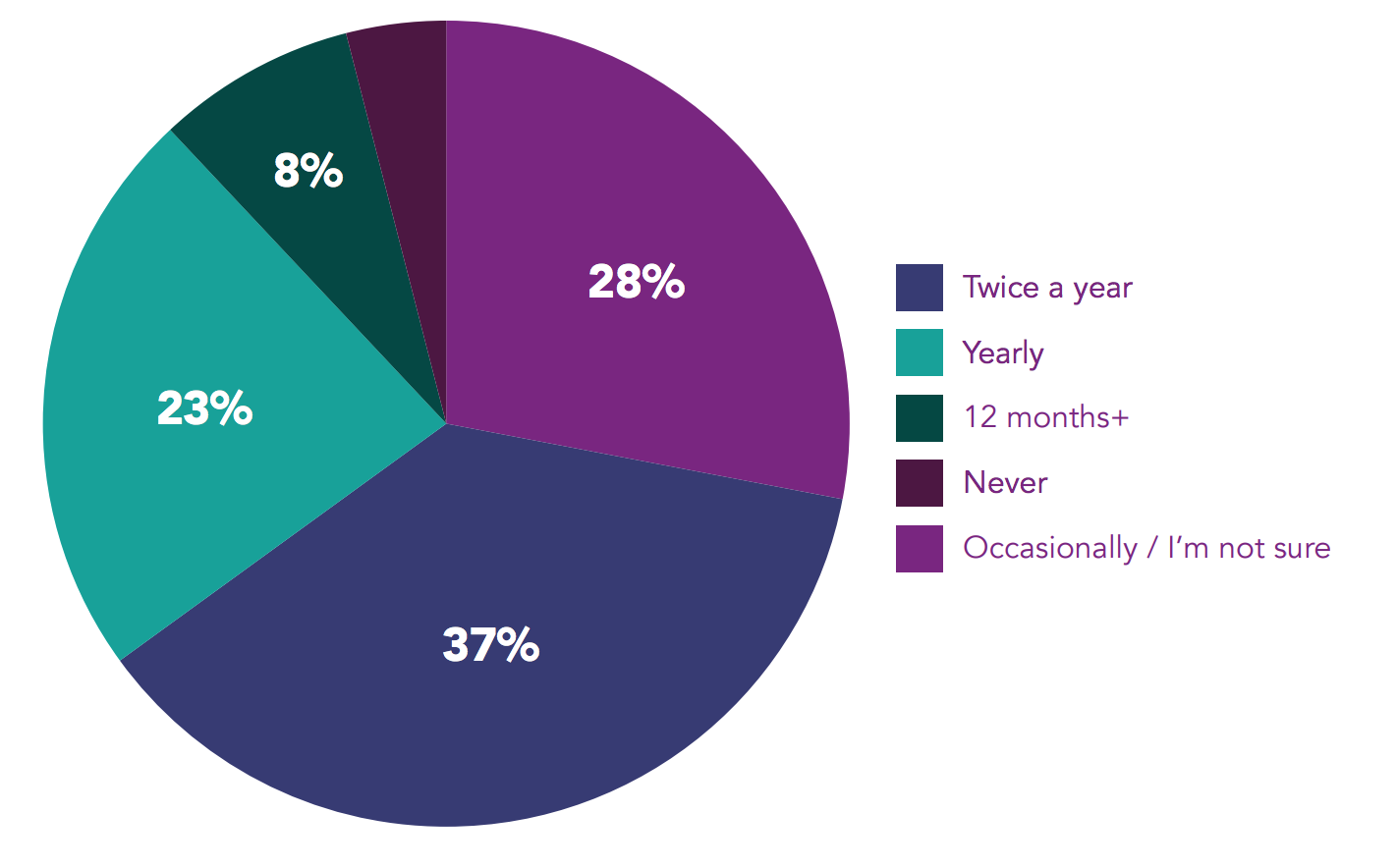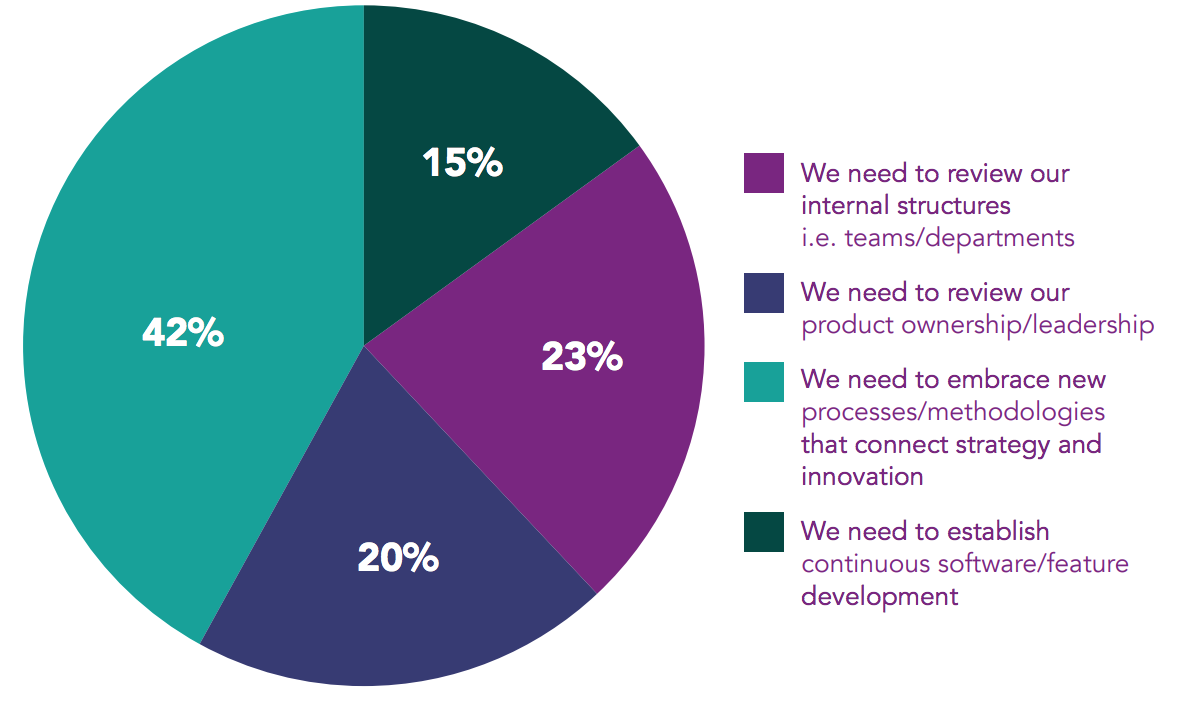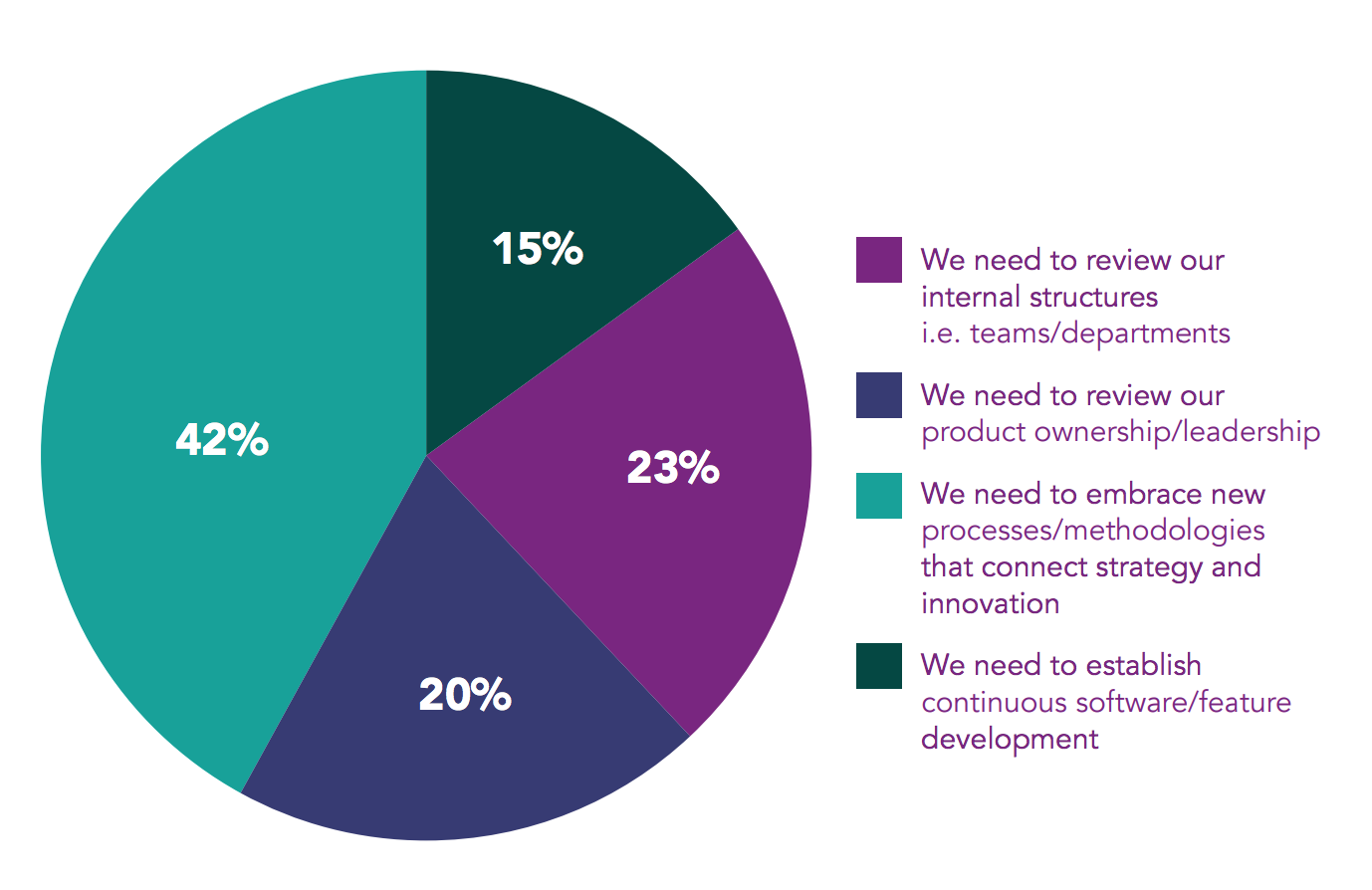Mind the digital gap: aligning strategy and delivery
Executive summary
Organisations are failing to align business strategy and digital delivery – and customer experiences are suffering as a direct result.
That’s the headline takeaway from this report into digital delivery, which reveals that organisations are failing to balance the demands of day-to-day business operations with investment in digital innovation to drive the business forward.
Here at Inviqa we believe that where there is a ‘digital gap’ – in other words, a disconnect between business strategy and the teams responsible for delivering digital products – organisations struggle to improve customer experiences and miss opportunities to innovate.
Our research and commentary evaluates businesses’ internal structures, processes, and behaviours, and sheds light on the changes they can make to create alignment and enable delivery teams to execute the strategy set by business stakeholders.
Our aim in publishing this report is to raise awareness of what businesses can do to establish a virtuous circle of the right processes, practices, and methodologies to achieve their objectives, support digital innovation, and deliver digital products that continue to exceed customer expectations.
Research sample
This research was conducted during July–August 2017. A multiple-choice survey was completed by 100 UK-based senior digital managers in roles such as: chief information officer (CIO), chief digital officer, head of digital, head of IT, technical director, head of digital delivery, digital operations director, head of digital engagement, head of digital experiences, and so on.
The majority of respondents (69%) are from enterprises that have been trading for more than 15 years. These businesses span a variety of industries, predominantly: technology (18%), media and publishing (18%), professional services (12%), retail (12%), manufacturing (7%), public sector (7%), and not-for-profit (7%).
These organisations largely have ‘some in-house employed digital capability’ (49%). 25% have ‘significant in-house digital capability [20+ engineers]’, 11% rely on consultancies or external teams to augment their in-house (and / or remote) teams, and 15% mostly outsource their digital work.
Headline findings
Organisations are struggling to deliver joined-up digital experiences that meet or exceed customer expectations. Our research suggests that this is because they are limited by organisational structures and unsuitable processes and methodologies.
Some of the report’s key findings are as follows:
- 68% of digital managers agree that internal structures and governance negatively affect their organisation’s ability to deliver effective customer journeys
- 53% believe their organisation is failing to balance the demands of day-to-day technical operations and technical innovation
- 72% ‘agree’ or ‘strongly agree’ that Agile creates better engagement across teams, but 44% are not currently using Agile in their organisations
- Almost half of respondents (45%) don’t have a formalised system in place for measuring the performance of their digital products and services
- 42% of digital managers believe that embracing new processes and methodologies that connect strategy and innovation is the most important change their organisation can make to improve customer experiences
- The ‘lack of internal agreement on where to focus efforts and resource’ is the number-one obstacle to achieving powerful customer experiences
- The ‘time it takes to deliver digital initiatives’ is perceived as the biggest obstacle to achieving business goals
This report explores the findings in full, offering analysis and commentary from Inviqa consultants on how organisations can better align business strategy and digital delivery.
Research commentary
Internal structures and governance
Organisational structures impact a business’ ability to align business strategy and digital delivery. This in turn impacts an organisation’s ability to deliver digital experiences that meet or exceed customer expectations.
Concerningly, the majority of the digital managers we surveyed (68%) believe their business’ organisational structures are having a negative influence on their ability to deliver effective customer journeys.
The silo problem
Part of the problem may be what McKinsey describes as1 the ‘siloed nature’ of service delivery. Legacy internal structures, McKinsey explains, often encourage a siloed approach focused on individual customer touchpoints rather than focusing on the task of delivering integrated customer journeys.
Indeed the majority (80%) of those we surveyed do not structure teams around major customer journeys. Many, for example, have a central IT team that also owns all digital development, including frontend development and project-based work (34%), and others, for example, say their digital teams are organised around individual customer touchpoints (13%).
By having teams and structures in place around individual touchpoints, organisations are operating in silos and are failing to examine their users’ cumulative experiences across multiple touchpoints and channels. With 75% of people expecting a consistent experience2 wherever they engage with brands, the risks of a siloed approach are clear. What’s clear is that, as the number of touchpoints and channels continues to grow, organisations with a siloed approach to service delivery will surely struggle to improve the performance of their services and experiences in meaningful ways.
Back in the ’60’s programmer Melvin Conway made the observation that an organisation’s structure has a powerful effect on the software it produces, and that organisations with larger teams tend to create larger, monolithic systems. Since then many organisations have recognised this link between organisational structure and digital products and have evolved new structures that make it easier to adapt digital products in response to evolving customer expectations.
- 80% do not structure teams around customer journeys
- 68% believe internal structures negatively affect customer journeys
- 45% don’t have a system for measuring digital performance
Understanding the full customer experience
With growing expectations for integrated digital experiences, brands cannot afford to measure customer experience and satisfaction in silos based on individual customer touchpoints. Research from McKinsey3 puts this into perspective; it shows that measuring satisfaction based on customer journeys is 30% more predictive of overall customer satisfaction than measuring happiness for individual interactions and channels.
But with 80% of respondents’ businesses failing to organise themselves around major customer journeys, it appears that legacy structures could be preventing them from understanding how their digital products perform against end-to-end journeys.
The split is fairly even between those companies that analyse performance against defined customer journeys (25%) and those that measure the performance of individual touchpoints (27%). But concerningly, a significant 45% of organisations still don’t have any formalised system in place for measuring the performance of their digital products and services. This suggests that business cases for digital initiatives are being created (and approved) without any plan for measuring success.
Without being able to verify what is and isn’t working, these organisations stand little chance of being able to test and learn what resonates with their customers. It’s little surprise then that almost a third of digital managers (29%) believe ‘not having a comprehensive understanding of customers’ is currently the greatest obstacle to achieving powerful customer experiences.
This inability to understand the customer may also be indicative of a fundamental lack of communication and data flow across different business functions and departments, which is symptomatic of operating in silos. According to a Dimension Data4 study, for example, 52% of companies are failing to share customer intelligence beyond the contact centre, leaving many areas of the business in the dark as to how customers feel about digital products and services.
Breaking the old mould
A siloed digital environment focused on individual touchpoints and disparate legacy systems makes it challenging for organisations to improve their understanding of their users and to improve their digital products and services accordingly. So how can organisations progress towards thinking and acting in terms of customer journeys, rather than traditional touchpoints?
It’s a change that can’t happen overnight. As McKinsey notes5, it requires ‘an operational and culture shift’ that engages the organisation across different functions of the business – from top to bottom. It means breaking down organisational walls and restrictive departmental silos, which 42% of executives believe is now the greatest internal barrier to digital transformation6.
Achieving this requires organisations to work collaboratively to review existing structures and identify those that best support a business’ strategic goals. The good news is that our findings suggest that organisations are already regularly reviewing their internal structures. Only 4% of respondents say their organisation ‘never’ reviews internal governance around digital delivery, with the majority reviewing internal governance twice yearly (37%), or yearly (23%).
But with the majority of digital managers believing that their internal structures negatively affect customer journeys – and with 23% of respondents identifying the need to ‘review internal structures across teams and departments’ as the most important change their organisation can make to improve customer experiences – there is clearly a need to formalise the review process and ensure it yields actionable insight. Companies recognise a need to organise in different ways, but there seems to be a lack of understanding as to how structures can align strategy and digital delivery.

Many digital innovators are seeing value in fluid structures that enable them to move, iterate, and learn faster. This is significant when you consider that 41.4% of respondents see ‘the time it takes to deliver digital initiatives’ as the biggest obstacle to achieving their organisation’s goals.
Netflix and Amazon, for example, are structured around multiple small teams, each responsible for one part of the system. Each team owns the entire lifecycle of its particular service – an arrangement that provides them with autonomy and the ability to quickly deliver value to the customer since each service can be adapted independently from the others.
Whatever shape an organisation’s structure takes, that structure will need to be continually revised, with methods in place to measure its impact, to ensure clear governance and communication, and to create lasting change.
There’s a growing body of evidence that flexible organisational structures focused on assigning dedicated teams and leaders to major customer journeys can achieve higher customer satisfaction. These cross-functional teams should include representatives from across your different customer touch points, as well as from supporting teams such as marketing. This will foster a customer-centric approach, where cross-unit teams work to solve problems collaboratively and iteratively.
Methodologies, processes, and capabilities
At Inviqa, we believe businesses need to adopt methodologies and processes that give them the agility to change direction and create new capabilities quickly as new technologies and consumer demands emerge.
Digital managers seem to agree. 42% say that the most important change their organisation can make to improve customer experiences is to ‘embrace new processes and methodologies that connect strategy and innovation’.
Accelerating Agile adoption
Agile principles are increasingly used to develop and deploy digital products and services, because their flexibility gets businesses to market faster, while the transparency gives business stakeholders sight of a product much earlier on.
With 72% of digital managers agreeing or strongly agreeing that Agile creates better engagement across teams – and with 72% of respondents in agreement that ‘business people should join Agile teams – it’s clear that Agile methodologies can help align business stakeholders and the teams responsible for producing digital products.
Despite this enthusiasm for Agile, only 56% say their organisations are using Agile methodologies to identify customer journeys and prioritise development work. 44% are not using Agile at all, and 32% say they ‘use Agile methodologies but want to do more’.
Our question did not specify whether Agile adoption applied to technical teams alone, or the wider business, but in the world’s longest-running Agile study7, 94% of respondents said that while their organisations practice Agile, more than half of their organisations’ wider teams are not yet practicing Agile, despite the fact that 98% of those organisation realised success from Agile projects.
Agile is far from ingrained in our respondents’ organisations and it’s clear that those using Agile are failing to do so effectively; two thirds of the people who say the time it takes to deliver digital initiatives is the biggest obstacle to achieving the organisation’s goals are already using Agile methodologies.
Agile teams and agile businesses are naturally different things. Agile is not a silver bullet for creating better customer experiences, and its methodologies are more effective in businesses that are characterised by alignment and collaboration. While training helps digital teams get up-to-speed with Agile methodologies, Agile coaching is valuable in helping embed agility within an organisation.

Digital managers seem unclear on the differences between the two, however; the majority (62%) were undecided about whether Agile training is more effective than Agile coaching. There’s an argument then that the digital partners and consultants who provide such services need to make a stronger case for the business benefits of Agile coaching and techniques that help organisations adopt an Agile mindset.
Whatever your methodologies, however, the tools and approaches your business deploys will only deliver value if you have the right capabilities in your digital teams and in the agencies you employ, and a means of measuring that value.
The Agile technique of ‘Impact mapping’ is a simple and effective way to identify the behaviours you need to support and achieve your digital initiative’s objective. Using a collaborative approach, it uncovers alternative, non-obvious ways of achieving objectives that you won’t always uncover using more conventional approaches. Ultimately, it helps businesses move away from achieving accidental business impact when focusing on feature delivery, towards creating accidental feature delivery by focusing on business impact.
- 72% think business people should join Agile teams
- 44% of businesses are not using Agile in any way
- 53% believe they are failing to balance day-to-day operations with innovation
Building in-house capabilities
When asked about achieving powerful customer experiences, 12% say the key obstacle is that their organisation ‘lacks the capability internally to deliver on our ideas’. While some capabilities should be at your core, others could and should be resourced externally. Getting the right balance is important.
Organisations have much to benefit from building long-term relationships with partners who can help them to develop and execute digital strategies for future growth and build a legacy of sound processes, practices, and methodologies.
Agile coaching, as we have discussed, helps organisations to achieve the cultural change that’s required to become a lean, valuefocused business. For example, with Agile coaching software company Softonic was able to alleviate team pressures while improving productivity. Softonic drastically improved its market positioning, moving from fourth-largest download software company in the world to global leader within the space of a year.
Building capability versus buying capacity
While the use of outsourced teams allows you to buy capacity in the short-term, it won’t enable your in-house software team to significantly develop and grow their capabilities in the long-term. But embedding experienced, external developers within your team can accelerate your team’s development through an exchange of knowledge, skills, and ideas.
International payments provider WorldFirst, for example, uses a team of on-site Inviqa developers to help the company’s own developer teams become more effective through close, collaborative working. Well-versed with key technology frameworks, Inviqa’s experts have been able to accelerate WorldFirst’s software set-up and quickly resolve compatibility issues.
It’s no longer enough for your technology partner to handle implementation alone; they should be empowering your teams to build capabilities and deliver more value, through consultancy and coaching, to continuous improvement support. Look for technology partners who are well-versed in the technology you are proposing, backed by compelling testimonials, and focused on helping you achieve your strategic goals.
There’s a growing body of evidence that proves the value of this approach. Pair programming, for example, whereby two programmers work side-by-side on the same project, clearly improves software quality and reduces time to market. And there’s arguably even more to be gained if an in-house developer’s ‘pair’ partner is an external expert who can offer an alternative perspective, plus different skillsets and approaches.
While the presence of a dedicated and trusted product owner who acts on behalf of the business interests is vital to the success of an Agile team, it’s also important that the right person be selected for the job. I’ve seen many Agile efforts fail because of poor communication and decision-making skills in the person selected for the product owner role, or a lack of mandate or seniority within the business in general. In these cases, the product owner simply becomes a go-between, or, at worst, a bottleneck with no real power to improve the speed of iteration.
Behaviour and culture
Internal alignment is key to establishing a culture of digital innovation. Unfortunately, a lack of internal alignment means that the majority of our respondents (53%) believe their organisation is failing to balance the demands between day-to-day technical operations and technical innovation.
Product ownership
Product ownership – in helping to align strategy and digital delivery – is a key part of cultivating an effective digital culture. To cite Agile’s SCRUM manifesto, product owners play an integral role in aligning strategy and delivery by focusing on value, gathering feedback, making decisions, and ensuring the voice of the customer is heard. As the bridge between strategic and delivery teams, the product owner has never been more valuable in helping you manage your brand effectively across a growing array of new channels.
But more than a third of respondents (35.6%) say their organisations do not have a recognised product owner (or product owners) despite the fact that having an effective product owner has a positive impact on revenue8. Budget constraints are cited as a leading reason (24%) for the lack of product ownership, while 19% cite the lack of a business case. Internal structures, however, are again seen as the major blocker, with 26% saying that the lack of product ownership is due to a ‘team structure that doesn’t lend itself to the role’.
Interestingly, 70% of organisations without a legacy of product ownership are those where internal structures are perceived as having a negative influence on customer experiences. This could suggest that harmful structures are often characterised by a lack of product ownership. And while the majority of respondents (63%) do observe product ownership within their organisations, 20% of respondents cited the need to ‘review product ownership and leadership’ as the most important change their organisation can make to improve customer experiences. This suggests that, whatever form that product ownership currently takes, it’s not working effectively for these organisations.
In our experience, product ownership is far more effective where an organisation has appointed a dedicated product owner who understands the value of investing time into aligning strategy-makers and digital teams. Establishing internal structures that support product ownership and building a business case for this role is therefore crucial.
Build, measure, learn
An appetite for risk and rapid experimentation is also key to building an effective digital culture. In many cases, there’s greater value in fast experimentation and rapid iteration, which enables you to measure and learn quickly, than going to market with a fully-formed solution.
Working iteratively and enabling ‘data-led continuous improvement’ allows your digital products to continue to address real and changing customer needs against measurable business objectives.
Start by launching a ‘minimum viable product’ (MVP), the most basic commercially-viable digital solution that achieves traction towards your business objective. This approach enables you to move faster than your competitors and establishes a base from which to further enhance your solution. Then use data (ideally real-time) to learn what creates value for your customers and react to what is happening now, keeping your customer proposition current and relevant.
Given that 44% of respondents are not currently using Agile in their organisations, it’s more likely that their organisations emphasise fullydeveloped solutions versus the ‘minimum viable product’ approach to delivery. This may be why the time it takes to deliver digital initiatives was identified by the majority of respondents (35%) as the biggest blocker to achieving the organisation’s goals.
But this longer time to market in the pursuit of software perfection is hardly paying off, with almost a third of respondents (31%) saying that they are releasing digital products where they find issues ‘all the time’.

As development workflow tools including automated testing and container-based development become more accessible we may see a trend towards fewer issues in deployments. With the emergence of tools such as ContinuousPipe, for example, organisations now have the means to ensure individual features are quality assured in live environments before they’re even deployed.
With the pace of change quickening in terms of technology, competition, and customer expectation, waiting to develop a ‘minimum viable product’ – or ‘MVP’ – might in itself be a little too slow. Instead, organisations should consider the benefits of experiments and prototyping before developing an MVP. By testing the smallest element possible, and by learning about customers’ responses, you can prioritise or re-prioritise your MVP development based on empirical evidence rather than assumptions.
Shifting mindsets to continuous improvement
When asked about the most important change their organisations should make to improve customer experiences, respondents selected issues to do with leadership (20%), structures (23%), and processes that align strategy and delivery (42%), with only 15% selecting an issue to do with the nature of digital delivery itself. What’s more, leadership was identified as the key ingredient for improving customer experiences, with 39% of respondents identifying the ‘lack of internal agreement on where to focus efforts and resource’ as the greatest obstacle to achieving powerful customer experiences.
So if delivering better customer experiences and improving the balance between day-today technical operations and digital innovation is about investment, structures, process, and leadership, it will require a mindset change that may fall outside the natural comfort zone for an organisation’s leadership team.
Digital investment has historically been focused on a one-off project basis where resources are focused on achieving a specific objective. A goal post is determined, a business case devised, and efforts are mobilised to achieve it. The inherent flaw with this approach is that it assumes an endgame, but the reality is that the business roadmap needs to constantly evolve in-line with continually-changing technology and consumer expectations.

Continuous improvement requires businesses to monitor the performance of digital initiatives on a detailed level, using that insight to shape and inform opportunities to improve and grow. With almost half of respondents still lacking a formalised system in place for measuring the performance of their digital products and services – and with organisations currently using less than a third of the relevant data available to them9 to inform real-time customer interactions – it’s imperative that organisations start using and responding to real-time insight to keep their customer proposition current and relevant.
Leadership’s thinking needs to shift towards programmes of continuous improvement and internal business processes will need to reflect this change. Operations, finance, production, for example, will each need to support this new direction in order for it to be a success. For many organisations, their internal risk model, project governance, and financial models are geared towards a start-to-finish project approach with a defined ‘end’. These will need to be revised to fit a new way of working which doesn’t have a traditional finish line.
Concluding remarks
Customer experience is set to overtake price and product10 as the key brand differentiator by 2020. With more than 50%11 of organisations expected to redirect their investments to customer experience innovations by 2018, brands are clearly taking note. But despite recognising the importance of customer experience, many organisations are failing to align business strategy and digital delivery, and are therefore jeopardising the digital experiences they deliver as a result.
Alignment is what’s needed to ensure digital teams build what matters most to the business and its users while giving development teams the autonomy to decide the best way to build that product or service. It requires businesses to dismantle internal silos and legacy systems that compromise agility, and develop processes and digital capabilities to establish a digital culture centred on innovation. These are all areas where experienced technology partners and consultants have much to offer, but they are changes that must be driven internally, embraced by every aspect of the business, and championed by leadership teams.
Achieving this alignment is fundamental to becoming a customer-centric organisation, which translates into tangible business gain. For example, customers who receive great digital experiences are more likely to purchase from the same company again12, and engaged, satisfied customers buy 50% more frequently, spending 200% more each year13.
Those businesses that act now to establish the right processes, practices, and methodologies to create alignment and close the digital gap clearly have much to gain.
Failing to meet the needs and expectations of your customers affects customer retention and sales – and ultimately impacts on your bottom line. That’s why it’s key to align your business strategy and digital capability to ensure customer experiences remain optimised. Businesses that commit to investing in this approach typically benefit through longer and more fruitful relationships with their customers.





